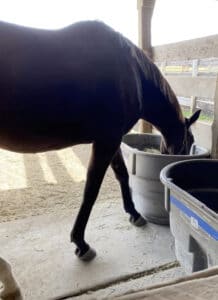Horses often turn up their noses when a new hay is on the menu. Knowing this, University of Kentucky researchers set out to compare what horses would do when presented with a highly palatable hay that had never previously been part of their diet.
Preference and eating behaviours primarily depend on the horse’s previous exposure to a particular type of hay and its maturity (indicated by its fineness and soft stems), notes lead author of “Acceptability of red clover hay and associated eating behaviors of horses when compared to timothy hay” Kristen Krebs, who presented the paper to the 2021 Equine Science Society Virtual Symposium earlier this year.
Red clover is right up there on the palatability preference list according to past research, notes Krebs. It’s a cool-season grass, a legume, fine and soft-stemmed, highly digestible, and low in fibre.
A major downside, however, is that it’s prone to developing the fungus Rhizoctonia leguminicola, which contains the toxin slaframine. In horses, this causes the condition, black patch disease – better known as slobbers. This creates excessive salivation and increased water intake. While messy and inconvenient, it’s thankfully not considered a major health crisis. And, says Krebs, past research indicates feeding red clover as hay versus pasture could limit the slobbery impacts.
Hmmm, Do I Want This or That?

One of the study’s horses having a chow down on some timothy hay. (Photo by Kristen Krebs, University of Kentucky)
For the study, 12 mature Thoroughbreds were separated into two blocks of six geldings and six mares, further blocked by body weight. They were housed in partially covered limestone-floored individual runs with rubber mats near their feed bins and automatic waterers. The horses were turned out six hours a day in muzzles to prevent grazing but that allowed for drinking.
Horses participated in three preference tests over four weeks: one in week two and two in week four on consecutive days (these results were averaged to represent a single test). Having been on pasture before the study, they transitioned to hay-only diets during week one, when they also adapted to their herdmates, housing and management.
Treatments were randomly assigned to the horses. One was timothy hay only treatment, the other was a timothy-red clover choice. (On the week in which testing occurred on two consecutive days, the hays were switched to the opposite bins.)
According to the study, “Each successive PF [preference test] served to test acceptability with continued exposure.]”
On test days, the horses were individual brought in from pasture into individual runs where, instead of getting their full allotment of hay, were given a pre-weighed amount of hay in two bins (timothy-timothy or timothy-red clover). The horses were free to eat from either bin. Researchers recorded which bin the horse initially approached, sniffed and ate from first and then observed for an hour its eating patterns, water intake and any non-eating distractions greater than one minute.
Slaframine toxicosis symptoms were also monitored.
After the hour, the bins were removed and orts (hay remaining in the feeder) were weighed and then returned to the horses along with their regular day’s hay allotment.
And the Winner Is …
- Total hay consumption did not differ between treatment or over time for each preference test.
- Timothy hay consumption differed initially, then was similar over test two and three. Krebs explains the treatments may have different on day one of testing because the horses, although adapted to the diet, had not been fed in separate bins before.
- Red clover hay consumption decreased initially and then remained the same. “Just to clarify, this is the horses that were given the red clover choice treatment only, so we saw that from test day one to test day two the red clover hay decreased, while the timothy hay increased,” explains Krebs. “This could indicate that there is a preference to consume that timothy grass over time when offered the choice and that forge was available.”
- There was a willingness to eat both hays, but horses indicated a preference for timothy. “Whether due to differences in maturity or other sensory factors,” notes the report. This result supported the study’s hypothesis.
- Bin placement and whether red clover was in the bin had no effect on consumption.
- The average dry-matter intake of red clover hay was 30.7 per cent for all tests. Says Krebs, “Which indicates that even though there is a preference for the timothy hay the red clover hay was still accepted and consumed. In addition, the red clover hay was approached and sniffed first more often, however, was only consumed half the amount of time.”
- No slaframine toxicosis symptoms were observed over the 28-day trial.
Horses stopped eating and showed distracted behaviours an average three times (for less than a minute) and drank water twice on average during the tests but this “did not impact preference for [hay] intake.”
The study, in part, wanted to ascertain whether horses could be fed red clover at 15 to 20 per cent of their total intake of hay, as it’s been shown to be beneficial in steers. As Krebs says, the willingness for this study’s horses to consume red clover hay at the rate of 30.7 per cent “may indicate a benefit and a management opportunity for these similar feeding practices.”
But, for the majority of us, the research suggests we save our money by buying good old timothy for our horses and leaving the red clover for the beef cattle.

